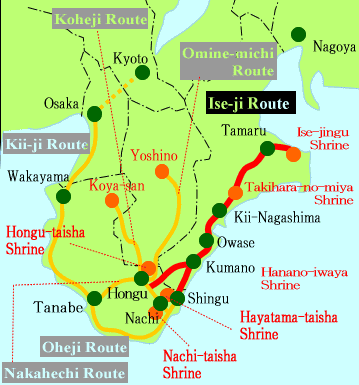|
|
 |
| HOME >> What
is Kumano Kodo? |
 |
 What is Kumano Kodo? What is Kumano Kodo? |
Kumano Kodo is the pilgrimage road that lead to Kumano Sanzan (the three grand shrines of Kumano: Hongu-taisha, Hayatama-taisha, Nachi-taisha). Kumano is located south of Yoshino, honored as a sacred place where the
gods have lived since ancient times. People entrust their future happiness
to the gods by traversing rugged paths through wild nature to visit Kumano.
This is called "Kumano Mode".
( "mode" literally means "visit")

Hongu-taisha Shrine in Hongu-cho Town, Wakayama. |

Nachi-taisha Shrine in Nachi-Katsuura-cho Town, Wakayama.
The object of worship in this shrine is this falls "Nachi-ootaki Falls.
" |
In the middle of the Heian era, when Kumano Sanzan was formed, roads
and rests were maintained because of the emperor's or retired emperor's
trips along the Kumano Kodo. So, "Kumano-mode" became more
and more popular.
Afterwards, since the religion spread from the Imperial House to the ordinary
people, many pilgrims visited Kumano. The lines of pilgrims seemed like
the ants, so it was called " pilgrimage of ants to Kumano". The reason for the huge
spread of the religion was because the gods
of Kumano are generous and accept anybody, without regards to status
or gender.
 |
The former symbol of Kumano Kodo in Mie.
The picture is based on the image of " pilgrimage of ants to Kumano". |
 |
The symbol of "Sacred Sites and Pilgrimage Routes in the Kii Mountain
Range, and the Cultural Landscapes that Surround Them." This is the
common symbol among Wakayama, Nara and Mie prefecture.
Three mountains represent "Kumano sanzan," "Yoshino Oomine"
and "Kouyasan, " and the road through them represents pilgrimage
road including Kumano Kodo. |

Hayatama-taisha Shrine in Shingu, Wakayama. |
It was in Edo period ( the beginning of the 17th century) that the
paths for "Kumano- mode" were created and maintained. An
ancient feudal load of the Kisyu Clan, Yorinobu Tokugawa, made much effort in the maintenance of roads and in advancing various
policies of the clan government. He added "Ise-ji Route" (Shingu
to Ise) to Ki-ji Route"( Wakayama to Shingu) as a political communication
road, named Kumano-kaido. |
 About the World Heritage About the World Heritage |
"Kumano Kodo" is a part of the World Heritage "Sacred Sites and Pilgrimage Routes in the Kii Mountain Range." It is inscribed on the World Heritage List in July 2004.
It isn't only because of beautiful stone path, nice view and beautiful
forests in "Kumano Kodo," but also because of it's living culture
as sacred sites. |
| @ |
>Brief Description (from UNESCO World Heritage Centre's web site)
-Set in the dense forests of the Kii Mountains overlooking the Pacific
Ocean, three sacred sites - Yoshino and Omine, Kumano Sanzan, and Koyasan
- linked by pilgrimage routes to the ancient capital cities of Nara and
Kyoto, reflect the fusion of Shinto, rooted in the ancient tradition of
nature worship in Japan, and Buddhism, which was introduced to Japan from
China and the Korean peninsula. The sites (495.3-ha) and their surrounding
forest landscape reflect a persistent and extraordinarily well-documented
tradition of sacred mountains over 1,200 years. The area, with its abundance
of streams, rivers and waterfalls, is still part of the living culture
of Japan and is much visited for ritual purposes and hiking, with up to
15 million visitors annually. Each of the three sites contains shrines,
some of which were founded as early as the 9th century.
>Justification for Inscription (from UNESCO World Heritage Centre's web site)
-Criterion (ii): The monuments and sites that form the cultural
landscape of the Kii Mountains are a unique fusion between Shintoism and
Buddhism that illustrates the interchange and development of religious cultures
in East Asia.
-Criterion (iii): The Shinto shrines and Buddhist temples in the Kii
Mountains, and their associated rituals, bear exceptional testimony to the
development of Japanfs religious culture over more than a thousand years.
-Criterion (iv): The Kii Mountains have become the setting for the
creation of unique forms of shrine and temple buildings which have had a
profound influence on the building of temples and shrines elsewhere in
Japan.
-Criterion (vi): Together, the sites and the forest landscape of the
Kii Mountains reflect a persistent and extraordinarily well-documented tradition
of sacred mountains over the past 1200 years. |
 The variety of Kumano Kodo The variety of Kumano Kodo |
"Kumano-mode" became popular and had
various routes from each region. Referring to the map, it has divided into 6 routes ( Ki-ji Route, Ohe-ji
Route, Nakahe-ji Route, Kohe-ji Route, Omine-do Route, Ise-ji Route).
Among those routes, "Ise-ji Route"
was the most popular, leading to Kumano Sanzan from Ise Jingu (Great Shrine of Ise).
In contrast with "Ki-ji Route",
the route along to the west coast of the Kii peninsula used by the
emperor or retired emperor, "Ise-ji Route"
was the route for ordinary people.
The travelers returning from Ise Jingu, or the pilgrims returning
from the "33- point Pilgrimage in the west" passed the route
on their way home. |

 |
ŁThe variety of Kumano Kodo |
 Mie Prefecture's pride, "Ise-ji Route" Mie Prefecture's pride, "Ise-ji Route" |
The popular route "Ise-ji Route" is mentioned in a popular text
of Edo-period, "Tokaidochuhizakurige".
It says that "seven times to Ise, three times to Kumano, and
every month to Atago".
The main route of this rugged path is from Ouchiyama Villadge to Kumano
City. More than 10 passes span imperceptible distances, including Nizaka(Tsuzurato)-toge Pass, Hajikami-toge
Pass, Ikkoku-toge Pass, Magose-toge Pass, Yakiyama-goe, Miki-toge &
Hago-toge Pass, Sone-Jirozaka-Tarozaka, Nigishima-toge Pass, Okamizaka-toge
Pass, Obuki-toge Pass, Matsumoto-toge Pass and so forth.
The route includes many severe paths like "Yakiyama-goe(Crossing Mt.Yakiyama)"
which is believed to be "the hardest point in the west".
Additionally, these passes remain stone paths,
which are maintained today even as they were hundreds of years ago.
The paths themselves are left mostly undisturbed, safe
from development because of their rugged topography.
"Ise-ji Route" is a world heritage site that Mie Prefecture can
be proud of.
|
|
 |




